+ Open data
Open data
- Basic information
Basic information
| Entry | Database: PDB / ID: 6n4y | |||||||||
|---|---|---|---|---|---|---|---|---|---|---|
| Title | Metabotropic Glutamate Receptor 5 Extracellular Domain with Nb43 | |||||||||
 Components Components |
| |||||||||
 Keywords Keywords |  MEMBRANE PROTEIN / Cell Surface Receptor Nanobody MEMBRANE PROTEIN / Cell Surface Receptor Nanobody | |||||||||
| Function / homology |  Function and homology information Function and homology informationA2A adenosine receptor binding / phospholipase C-activating G protein-coupled glutamate receptor signaling pathway / G protein-coupled receptor activity involved in regulation of postsynaptic membrane potential / trans-synaptic signaling by endocannabinoid, modulating synaptic transmission / adenylate cyclase inhibiting G protein-coupled glutamate receptor activity / positive regulation of long-term neuronal synaptic plasticity / desensitization of G protein-coupled receptor signaling pathway / neurotransmitter receptor activity involved in regulation of postsynaptic cytosolic calcium ion concentration / astrocyte projection / G protein-coupled glutamate receptor signaling pathway ...A2A adenosine receptor binding / phospholipase C-activating G protein-coupled glutamate receptor signaling pathway / G protein-coupled receptor activity involved in regulation of postsynaptic membrane potential / trans-synaptic signaling by endocannabinoid, modulating synaptic transmission / adenylate cyclase inhibiting G protein-coupled glutamate receptor activity / positive regulation of long-term neuronal synaptic plasticity / desensitization of G protein-coupled receptor signaling pathway / neurotransmitter receptor activity involved in regulation of postsynaptic cytosolic calcium ion concentration / astrocyte projection / G protein-coupled glutamate receptor signaling pathway / Class C/3 (Metabotropic glutamate/pheromone receptors) / protein kinase C-activating G protein-coupled receptor signaling pathway /  glutamate receptor activity / Neurexins and neuroligins / protein tyrosine kinase activator activity / : / glutamate receptor activity / Neurexins and neuroligins / protein tyrosine kinase activator activity / : /  regulation of synaptic transmission, glutamatergic / regulation of synaptic transmission, glutamatergic /  protein tyrosine kinase binding / dendritic shaft / locomotory behavior / protein tyrosine kinase binding / dendritic shaft / locomotory behavior /  learning / G protein-coupled receptor activity / postsynaptic density membrane / synapse organization / Schaffer collateral - CA1 synapse / learning / G protein-coupled receptor activity / postsynaptic density membrane / synapse organization / Schaffer collateral - CA1 synapse /  cognition / cellular response to amyloid-beta / G alpha (q) signalling events / chemical synaptic transmission / positive regulation of MAPK cascade / cognition / cellular response to amyloid-beta / G alpha (q) signalling events / chemical synaptic transmission / positive regulation of MAPK cascade /  dendritic spine / learning or memory / glutamatergic synapse / dendritic spine / learning or memory / glutamatergic synapse /  dendrite / regulation of DNA-templated transcription / identical protein binding / dendrite / regulation of DNA-templated transcription / identical protein binding /  plasma membrane / plasma membrane /  cytoplasm cytoplasmSimilarity search - Function | |||||||||
| Biological species |   Homo sapiens (human) Homo sapiens (human)  Lama glama (llama) Lama glama (llama) | |||||||||
| Method |  X-RAY DIFFRACTION / X-RAY DIFFRACTION /  SYNCHROTRON / SYNCHROTRON /  MOLECULAR REPLACEMENT / Resolution: 3.262 Å MOLECULAR REPLACEMENT / Resolution: 3.262 Å | |||||||||
 Authors Authors | Koehl, A. / Hu, H. / Feng, D. / Sun, B. / Chu, M. / Weis, W.I. / Mathiesen, J.M. / Skiniotis, G. / Kobilka, B.K. | |||||||||
| Funding support |  United States, 2items United States, 2items
| |||||||||
 Citation Citation |  Journal: Nature / Year: 2019 Journal: Nature / Year: 2019Title: Structural insights into the activation of metabotropic glutamate receptors. Authors: Antoine Koehl / Hongli Hu / Dan Feng / Bingfa Sun / Yan Zhang / Michael J Robertson / Matthew Chu / Tong Sun Kobilka / Toon Laeremans / Jan Steyaert / Jeffrey Tarrasch / Somnath Dutta / ...Authors: Antoine Koehl / Hongli Hu / Dan Feng / Bingfa Sun / Yan Zhang / Michael J Robertson / Matthew Chu / Tong Sun Kobilka / Toon Laeremans / Jan Steyaert / Jeffrey Tarrasch / Somnath Dutta / Rasmus Fonseca / William I Weis / Jesper M Mathiesen / Georgios Skiniotis / Brian K Kobilka /     Abstract: Metabotropic glutamate receptors are family C G-protein-coupled receptors. They form obligate dimers and possess extracellular ligand-binding Venus flytrap domains, which are linked by cysteine-rich ...Metabotropic glutamate receptors are family C G-protein-coupled receptors. They form obligate dimers and possess extracellular ligand-binding Venus flytrap domains, which are linked by cysteine-rich domains to their 7-transmembrane domains. Spectroscopic studies show that signalling is a dynamic process, in which large-scale conformational changes underlie the transmission of signals from the extracellular Venus flytraps to the G protein-coupling domains-the 7-transmembrane domains-in the membrane. Here, using a combination of X-ray crystallography, cryo-electron microscopy and signalling studies, we present a structural framework for the activation mechanism of metabotropic glutamate receptor subtype 5. Our results show that agonist binding at the Venus flytraps leads to a compaction of the intersubunit dimer interface, thereby bringing the cysteine-rich domains into close proximity. Interactions between the cysteine-rich domains and the second extracellular loops of the receptor enable the rigid-body repositioning of the 7-transmembrane domains, which come into contact with each other to initiate signalling. | |||||||||
| History |
|
- Structure visualization
Structure visualization
| Structure viewer | Molecule:  Molmil Molmil Jmol/JSmol Jmol/JSmol |
|---|
- Downloads & links
Downloads & links
- Download
Download
| PDBx/mmCIF format |  6n4y.cif.gz 6n4y.cif.gz | 497.2 KB | Display |  PDBx/mmCIF format PDBx/mmCIF format |
|---|---|---|---|---|
| PDB format |  pdb6n4y.ent.gz pdb6n4y.ent.gz | 404.7 KB | Display |  PDB format PDB format |
| PDBx/mmJSON format |  6n4y.json.gz 6n4y.json.gz | Tree view |  PDBx/mmJSON format PDBx/mmJSON format | |
| Others |  Other downloads Other downloads |
-Validation report
| Arichive directory |  https://data.pdbj.org/pub/pdb/validation_reports/n4/6n4y https://data.pdbj.org/pub/pdb/validation_reports/n4/6n4y ftp://data.pdbj.org/pub/pdb/validation_reports/n4/6n4y ftp://data.pdbj.org/pub/pdb/validation_reports/n4/6n4y | HTTPS FTP |
|---|
-Related structure data
| Related structure data |  0345C  0346C  0347C 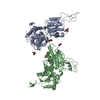 6n4xC 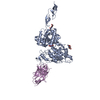 6n50C 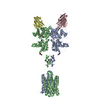 6n51C  6n52C 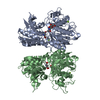 3lmkS S: Starting model for refinement C: citing same article ( |
|---|---|
| Similar structure data |
- Links
Links
- Assembly
Assembly
| Deposited unit | 
| ||||||||
|---|---|---|---|---|---|---|---|---|---|
| 1 | 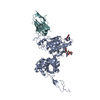
| ||||||||
| 2 | 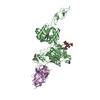
| ||||||||
| 3 | 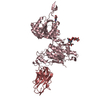
| ||||||||
| 4 | 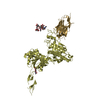
| ||||||||
| Unit cell |
|
- Components
Components
-Protein / Antibody , 2 types, 8 molecules ABCDEFGH
| #1: Protein |  / mGluR5 / mGluR5Mass: 67395.633 Da / Num. of mol.: 4 Source method: isolated from a genetically manipulated source Source: (gene. exp.)   Homo sapiens (human) / Gene: GRM5, GPRC1E, MGLUR5 / Plasmid: pVL1392 / Cell line (production host): High Five / Production host: Homo sapiens (human) / Gene: GRM5, GPRC1E, MGLUR5 / Plasmid: pVL1392 / Cell line (production host): High Five / Production host:   Trichoplusia ni (cabbage looper) / References: UniProt: P41594 Trichoplusia ni (cabbage looper) / References: UniProt: P41594#2: Antibody |  Single-domain antibody Single-domain antibodyMass: 13354.672 Da / Num. of mol.: 4 Source method: isolated from a genetically manipulated source Details: Nanobody 43 / Source: (gene. exp.)   Lama glama (llama) / Plasmid: PET SUMO / Production host: Lama glama (llama) / Plasmid: PET SUMO / Production host:   Escherichia coli BL21(DE3) (bacteria) / Strain (production host): BL21(DE3) Escherichia coli BL21(DE3) (bacteria) / Strain (production host): BL21(DE3) |
|---|
-Sugars , 5 types, 8 molecules 
| #3: Polysaccharide | 2-acetamido-2-deoxy-beta-D-glucopyranose-(1-4)-[alpha-L-fucopyranose-(1-6)]2-acetamido-2-deoxy-beta- ...2-acetamido-2-deoxy-beta-D-glucopyranose-(1-4)-[alpha-L-fucopyranose-(1-6)]2-acetamido-2-deoxy-beta-D-glucopyranose / Mass: 570.542 Da / Num. of mol.: 1 / Mass: 570.542 Da / Num. of mol.: 1Source method: isolated from a genetically manipulated source |
|---|---|
| #4: Polysaccharide | alpha-D-mannopyranose-(1-3)-[alpha-D-mannopyranose-(1-6)]beta-D-mannopyranose-(1-4)-2-acetamido-2- ...alpha-D-mannopyranose-(1-3)-[alpha-D-mannopyranose-(1-6)]beta-D-mannopyranose-(1-4)-2-acetamido-2-deoxy-beta-D-glucopyranose-(1-4)-[alpha-L-fucopyranose-(1-3)][alpha-L-fucopyranose-(1-6)]2-acetamido-2-deoxy-beta-D-glucopyranose / Mass: 1203.105 Da / Num. of mol.: 1 / Mass: 1203.105 Da / Num. of mol.: 1Source method: isolated from a genetically manipulated source |
| #5: Polysaccharide | alpha-D-mannopyranose-(1-3)-beta-D-mannopyranose-(1-3)-2-acetamido-2-deoxy-beta-D-glucopyranose-(1- ...alpha-D-mannopyranose-(1-3)-beta-D-mannopyranose-(1-3)-2-acetamido-2-deoxy-beta-D-glucopyranose-(1-4)-[alpha-L-fucopyranose-(1-6)]2-acetamido-2-deoxy-beta-D-glucopyranose / Mass: 894.823 Da / Num. of mol.: 1 / Mass: 894.823 Da / Num. of mol.: 1Source method: isolated from a genetically manipulated source |
| #6: Polysaccharide | alpha-D-mannopyranose-(1-6)-beta-D-mannopyranose-(1-4)-2-acetamido-2-deoxy-beta-D-glucopyranose-(1- ...alpha-D-mannopyranose-(1-6)-beta-D-mannopyranose-(1-4)-2-acetamido-2-deoxy-beta-D-glucopyranose-(1-4)-[alpha-L-fucopyranose-(1-3)][alpha-L-fucopyranose-(1-6)]2-acetamido-2-deoxy-beta-D-glucopyranose / Mass: 1040.964 Da / Num. of mol.: 1 / Mass: 1040.964 Da / Num. of mol.: 1Source method: isolated from a genetically manipulated source |
| #7: Sugar | ChemComp-NAG /  N-Acetylglucosamine N-Acetylglucosamine |
-Experimental details
-Experiment
| Experiment | Method:  X-RAY DIFFRACTION / Number of used crystals: 1 X-RAY DIFFRACTION / Number of used crystals: 1 |
|---|
- Sample preparation
Sample preparation
| Crystal | Density Matthews: 2.73 Å3/Da / Density % sol: 54.9 % |
|---|---|
Crystal grow | Temperature: 293 K / Method: vapor diffusion, hanging drop / pH: 7.5 Details: 18-20% PEG 3350 0.15M Potassium Nitrate 1% Benzamidine |
-Data collection
| Diffraction | Mean temperature: 100 K / Serial crystal experiment: N | ||||||||||||||||||||||||||||||
|---|---|---|---|---|---|---|---|---|---|---|---|---|---|---|---|---|---|---|---|---|---|---|---|---|---|---|---|---|---|---|---|
| Diffraction source | Source:  SYNCHROTRON / Site: SYNCHROTRON / Site:  SSRL SSRL  / Beamline: BL12-2 / Wavelength: 0.97946 Å / Beamline: BL12-2 / Wavelength: 0.97946 Å | ||||||||||||||||||||||||||||||
| Detector | Type: DECTRIS PILATUS 6M / Detector: PIXEL / Date: May 23, 2016 | ||||||||||||||||||||||||||||||
| Radiation | Protocol: SINGLE WAVELENGTH / Monochromatic (M) / Laue (L): M / Scattering type: x-ray | ||||||||||||||||||||||||||||||
| Radiation wavelength | Wavelength : 0.97946 Å / Relative weight: 1 : 0.97946 Å / Relative weight: 1 | ||||||||||||||||||||||||||||||
| Reflection | Resolution: 3.26→39.6 Å / Num. obs: 49878 / % possible obs: 98.4 % / Redundancy: 3.5 % / CC1/2: 0.926 / Rmerge(I) obs: 0.132 / Rpim(I) all: 0.083 / Rrim(I) all: 0.156 / Net I/σ(I): 7.6 / Num. measured all: 174911 / Scaling rejects: 21 | ||||||||||||||||||||||||||||||
| Reflection shell | Diffraction-ID: 1
|
- Processing
Processing
| Software |
| |||||||||||||||||||||||||||||||||||||||||||||||||||||||||||||||||||||||||||||||||||||||||||||||||||||||||
|---|---|---|---|---|---|---|---|---|---|---|---|---|---|---|---|---|---|---|---|---|---|---|---|---|---|---|---|---|---|---|---|---|---|---|---|---|---|---|---|---|---|---|---|---|---|---|---|---|---|---|---|---|---|---|---|---|---|---|---|---|---|---|---|---|---|---|---|---|---|---|---|---|---|---|---|---|---|---|---|---|---|---|---|---|---|---|---|---|---|---|---|---|---|---|---|---|---|---|---|---|---|---|---|---|---|---|
| Refinement | Method to determine structure : :  MOLECULAR REPLACEMENT MOLECULAR REPLACEMENTStarting model: 3LMK Resolution: 3.262→38.87 Å / SU ML: 0.46 / Cross valid method: THROUGHOUT / σ(F): 1.33 / Phase error: 28.09
| |||||||||||||||||||||||||||||||||||||||||||||||||||||||||||||||||||||||||||||||||||||||||||||||||||||||||
| Solvent computation | Shrinkage radii: 0.9 Å / VDW probe radii: 1.11 Å | |||||||||||||||||||||||||||||||||||||||||||||||||||||||||||||||||||||||||||||||||||||||||||||||||||||||||
| Displacement parameters | Biso max: 170.07 Å2 / Biso mean: 79.1425 Å2 / Biso min: 34.3 Å2 | |||||||||||||||||||||||||||||||||||||||||||||||||||||||||||||||||||||||||||||||||||||||||||||||||||||||||
| Refinement step | Cycle: final / Resolution: 3.262→38.87 Å
| |||||||||||||||||||||||||||||||||||||||||||||||||||||||||||||||||||||||||||||||||||||||||||||||||||||||||
| LS refinement shell | Refine-ID: X-RAY DIFFRACTION / Rfactor Rfree error: 0 / Total num. of bins used: 14
|
 Movie
Movie Controller
Controller



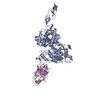



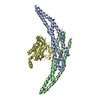

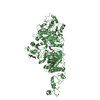

 PDBj
PDBj




